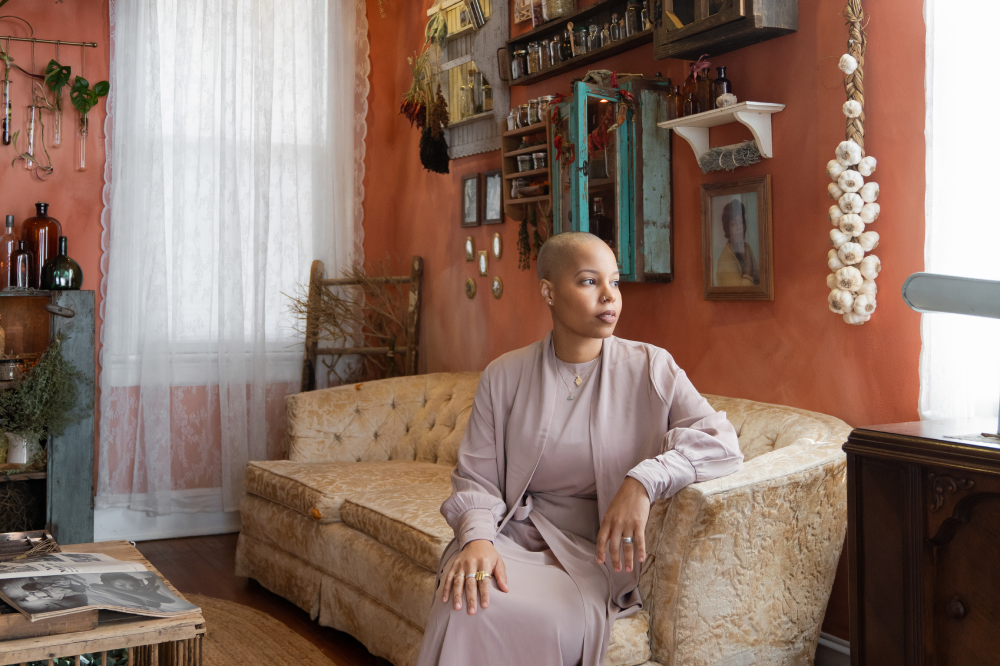Culture
 Artist Phylicia Ghee in exhibition space. Photo by Anne Kim.
Artist Phylicia Ghee in exhibition space. Photo by Anne Kim.
A Sacred Space: Artist Phylicia Ghee on “Liminality: A Story of Remembrance”
January 13, 2023 @ 12:00pm
Baltimore-based artist Phylicia Ghee communes with her ancestors, recovers family history, embraces herbal knowledge and womanist philosophies and commemorates female-centric spaces in her immersive, multi-sensory and richly detailed installation “Liminality: A Story of Remembrance” at The Nicholson Project, currently on view until January 28.
In “Liminality,” we enter another time that celebrates historical and ancestral Black women as lovingly reconstructed by a younger generation of creatives and caregivers. We enter another world, one that centers the lived experiences and deep knowledge of Black women, a space that is Afrofuturistic in creating a portal into an alternate, egalitarian past rooted in the domestic labor and healing arts of Black women; a space that is intimate, matriarchal and nurturing.
Ghee has decorated the first gallery wall with black and white portraits of her family and spiritual ancestors — herbalists, root women and midwives. Her grandmother’s portrait is centered in the charcoal-painted space above a Lucille Clifton poem creating a portal into generational healing and familial memory. Sounds of lapping water reverberate near a rose and rosewater basin, and visitors may sample an elderberry syrup drink — a ritualistic cleansing and communion. Essential oil perfumes — all inspired by Ghee’s maternal figures — are gathered together on a mirrored tray. This is a sacred space.
In the second gallery, we are embraced by warmth, family and healing. Dried herbs and flowers hang overhead and on the walls; the aromatic scents of sorghum, goldenrod, okra, lavender, scotch bonnet, holy basil and many other domestic medicinal ingredients blend into a heady savor. The sense of smell is the one most closely linked to deep memories, allowing every visitor to smell the herbs and recall the domestic spaces of their own childhoods. The room is painted an inviting terracotta color. White lace curtains, a grandmotherly cream brocade sofa and vintage shelves and armoires all bursting forth with aromatic and healing jars of spices, powders and tinctures finish the feminine space. The soundscape interweaves percussive and wind instruments, humming, Ghee’s niece’s heartbeat in utero and conversations with midwives and the women in her family. This space is home.
We spoke with Ghee about her residency at The Nicholson Project and the creation of “Liminality.”
District Fray: Can you tell us about the three-month residency at Nicholson?
Phylicia Ghee: I loved it. I found out I was accepted for the residency maybe a year before I was scheduled to move in. That gave me some time to prepare myself. I started to collect the items, and not even on purpose, the items kind of started to find me. I asked the resident gardener Peter Lewis to plant certain herbs for my work. The fact that there’s the garden is really special. The first day I moved in, there was a garden workshop about medicinal plants and creating tinctures. Stepanie Reiser [founder of The Nicholson Project] has a farm (Acknowledge), and she would forage and collect plants with her son, bringing in big bins. And then Allison [Nance] and Alanna [Reeves] — The Nicholson Project’s managing director and programs and communication manager — were so accommodating with my questions: Can we change this? Can we do this? It was a really beautiful experience. And the space is beautiful. The residency suite is an apartment upstairs; downstairs is the gallery and a kitchen area for openings and events. One time while sleeping, I swear I astral-traveled to the wash table below, in this hypnagogic liminal space, and it felt so real. It was a beautiful inter-dimensional experience because “Liminality” is about time and time travel. There is an Afrofuturistic component through the jumping of timelines, stepping out of this timeframe and into the experience of a different time. I was in the house by myself pretty much, where I could just sit with the stillness, listen and absorb. It was important to have that space. I’m a caregiver, so it was like a needed break. I took like a couple of weeks to settle in, rest and just be in the space, which was really nice.
That sounds lovely, but you’ve accomplished so much with this work. How did you do that?
I hit the ground running because I had to accomplish what I did in three months, which was near impossible. But it happened with the work of three of my friends who were with me every step of the way: Cathy [Guerra], Yvette [Guerra] and Shannon [Maith]. Cathy and Yvette helped me with this whole installation. We did some planning sessions and visited different spaces, and they helped me source materials and other items. The sofa was a gift from family friends, StrongHeart and Alana. It was really important for me to have items from grandmothers in the space, items from other women. I created this vision board with my friend Shannon, who helped me more on the conceptual side; we have a very similar aesthetic. So Cathy and Yvette helped a lot with logistics, planning and installation, while Shannon assisted a lot with the conceptual aspects and donated some of her family heirlooms. Many other friends helped along the way as well. Conversations with fellow Baltimore-based artist Krystal Mack influenced the outcome of some of the works in the front gallery space.
The space is so homey; it feels old-fashioned, in the past, safe and so feminine. How did you bring this all together?
In 2019, before I even applied to Nicholson, I knew this was a space I wanted to create. It was a space that existed just in my mind’s eye and my psyche for a long time as a space where I would meet with these women with my ancestors and talk about all these things. I knew I wanted certain colors, because the colors would come to me in a dream. If I had a dream of something [for this space], I would write that down.
You’ve created this beautiful space of feminine power and matriarchs — from the grandmothers to your friendships and collaborations with women. But it’s also about herbal knowledge, midwives, root women, this feminine knowledge that’s not always in books and often ignored by men and history.
I’ve always been intrigued by the journey of pregnancy and by the women who assisted even before I knew that as midwifery and herbalism. I’ve always been an artist and my grandfather is an artist; I learned a lot from him. My grandfather has a green thumb. His home is like a jungle. There are plants literally everywhere and so when people come to visit, they would be in awe, but that was just how I grew up. My mother studied as a pharmacist and pharmacy technician, but I knew I didn’t want to go that route. I am really interested in botanicals and what plants can do. Like, aromatic plants: lavender eases my anxiety. I started to notice this physiological response that I would have to certain plants and to herbal teas. Even though my grandfather worked with plants, he didn’t necessarily work with herbs, and even though my mother studied medicine, she didn’t necessarily study herbal medicine. That was part of creating this space: deepening those relationships and learning more about them.
You are studying herbalism now, too.
I knew I wanted to study herbalism and specifically wanted to [make that ] journey with a Black woman, because I felt like that was important to me to see myself reflected. I found a Black woman herbalist Karen Rose back in the day, during college. Ten years later, I decided to apply for an apprenticeship with Karen Rose, with the encouragement of a friend. So, now I’m really delving into my journey to become a clinical herbalist. The work itself has also afforded me other opportunities, and it has also done what I’ve been asking of it, which is to teach me about these women in my lineage who practiced these things. One of the ways that happened was when I was hanging all these photos around a wash table in the entryway when you first walk into the gallery space: 60 women who were herbalists, midwives and root women.
Can you tell us more about the portraits? Who is represented and commemorated?
When I went to hang the last couple of photos, the glass broke under my finger. And I took it as a sign that this woman does not want to be on the wall. She might not want to be in this space. So I didn’t hang that picture. And as I’m putting that picture aside, my great-great-grandmother Edna’s picture is there and she’s like, “You’ve got to put me up on this wall.” I put her picture up there, and I thought she must have done something that had to do with these [herbal and medicinal] things. What does that mean? My cousin Chris [Maizy’s daughter] texted me Grandma Edna’s obituary, which says she was a temple nurse. But then the story thickens, because on the night of the opening, Maizy and her daughter — they’re the record keepers of the family — tell me that I have seven generations represented in this exhibition, including myself. She says, “So you’re really following grandma’s footsteps. Didn’t you know that Grandma was an herbalist?” She told me that Grandma had a remedy for everything, all these jars around and a big garden. I didn’t know. That’s the question I’ve been asking, because my lineage and my family history has more questions than answers, partly because of the history of Black people in this country. But it was just so beautiful for Maizy to piece that together and tell me.
“Liminality: A Story of Remembrance” at The Nicholson Project is on view until January 28. The gallery is open Saturdays from 11 a.m.-4 p.m. and by appointment.
Phylicia Ghee has documented “Liminality: A Story of Remembrance” with artistic statements, installation photos, soundscape clips and more at phyliciagheeishome.carbonmade.com/liminality. Follow her on Instagram @phyliciaghee.
Ghee is giving an artist talk at The Nicholson Project on Saturday, January 14 at 1 p.m. RSVP here: https://www.eventbrite.com/e/artist-talk-with-phylicia-ghee-tickets-491925621777.
The Nicholson Project: 2310 Nicholson St. SE, DC; thenicholsonproject.org // @thenicholsonproject
Enjoy this piece? Consider becoming a member for access to our premium digital content. Support local journalism and start your membership today.







